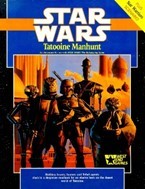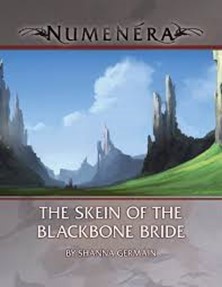I love Pathfinder, but much of my love of this hobby came from long before Pathfinder’s launch and since its release, other game companies have been putting out excellent work too. So, I thought I’d share some adventures that I love from other rulesets. Each of these adventures has influenced how I’ve approached storytelling in my home campaigns over the years. I’ve run each of these adventures multiple times or at least adapted portions of them for repeated use.
The titles in this list are presented in no particular order and each has a tip or two how you might approach including it or a portion of it in your Pathfinder campaign. I’ve also presented these adventures to be as spoiler free as possible but just so we’re clear…

WARNING! POSSIBLE SPOILERS FOLLOW!
X-1, The Isle of Dread (D&D, Wizard of the Coast) — This pulpy hex-crawl adventure is reminiscent of Skull Island or a lost world locale. This was the first adventure I ever played where the action happened outside of the dungeon. I spent many hours exploring and uncovering the secrets of jungles and swamps of the titular island and just as many or more running players through encounters that appeared in the module and sometimes encounters inspired by the module but of my own creation.
The Isle of Dread in your Pathfinder game: The Isle of dread was updated in Dungeon magazine and expanded on during the Savage Tide adventure path (also Dungeon Magazine). Any of these three versions of the island could be converted to Pathfinder whole cloth or piecemeal. There is much adventure inspiration to be found on the Isle of Dread.
 Shackled City Adventure Path (D&D 3.5, Paizo) — Okay Shackled City is probably the best-known adventure on this list and while I’ve only run the whole thing once it is a great adventure product and deserving of its place on this list. Shackled City hooked me from my first glimpse of Cauldron in Dungeon Magazine. It brought me back to Greyhawk, a campaign setting I never expected to be drawn back to. As the forerunner to the current Pathfinder APs it’s impossible to not at least mention this fantastic adventure path. Set in Cauldron, a city brazenly built in the caldera of a dormant volcano Shackled City is a complete campaign arc, following the heroes from their earliest adventures through the campaign’s ultimate challenges. It makes the PCs care about their hometown and the people in it, even their rivals. It also has one of the best villain introductions I have seen in an adventure product. The look on my player’s faces when they realized their first level PCs might be on the wrong end of a fight with a beholder was rather awesome.
Shackled City Adventure Path (D&D 3.5, Paizo) — Okay Shackled City is probably the best-known adventure on this list and while I’ve only run the whole thing once it is a great adventure product and deserving of its place on this list. Shackled City hooked me from my first glimpse of Cauldron in Dungeon Magazine. It brought me back to Greyhawk, a campaign setting I never expected to be drawn back to. As the forerunner to the current Pathfinder APs it’s impossible to not at least mention this fantastic adventure path. Set in Cauldron, a city brazenly built in the caldera of a dormant volcano Shackled City is a complete campaign arc, following the heroes from their earliest adventures through the campaign’s ultimate challenges. It makes the PCs care about their hometown and the people in it, even their rivals. It also has one of the best villain introductions I have seen in an adventure product. The look on my player’s faces when they realized their first level PCs might be on the wrong end of a fight with a beholder was rather awesome.
Shackled City in your Pathfinder game: If a GM is up to some light to moderate conversion work they could certainly run the whole thing with the Pathfinder rules. As it’s 3.5 D&D the conversion isn’t a huge hurdle but it can very be time-consuming. I started running Rise of the Runelords when it released and switched to Pathfinder when the beta playtest came out and updated again when the Core Rulebook released so it’s unlikely I’d attempt that again. That said, there are a lot of great ideas throughout this adventure path, such as how to effectively introduce a villain early in your campaign and keep them interacting with your PCs.
 Cabin Fever (Cyberpunk 2020, Atlas Games) —
Cabin Fever (Cyberpunk 2020, Atlas Games) —
It’s no secret that I’m a fan of the cyberpunk genre but there are some tropes that show up (maybe a little too) frequently. Occasionally it is nice to see those tropes subverted that’s where Cabin Fever steps in. Cabin Fever begins with a shady fixer hiring the PCs for an under the table for a heist on a mega-corporation. The target is on a ship due to arrive in the Night City Harbor. The PCs have some time to prep and plan but just as the PCs are about to begin their op everything goes sideways much earlier than normal. Before they have even had a chance to make a run at the ship, it explodes spewing acidic gas. Worse, the PC’s boat is damaged and they are forced to take shelter or die from gas exposure. At this point, the adventure gets a bit railroad-y because the plot assumes the PCs shelter in a specific bar. A GM can mitigate some of this by making the bar the only logical choice and leave it up to the PCs to “choose” their hole up point. So, what started as a standard cyberpunk story has just been turned into a locked room scenario. Here the adventure shines. The bar has an adequately detailed (albeit dull map) but in this close space, we have ample opportunities for roleplaying. The adventure details a number of NPCs each with their own personalities and motives. Typically, this adventure can be run in a single session and I’ve run it a few times. Once, I even tweaked it for use in a Werewolf game.
Cabin Fever in your Pathfinder Game: I love the idea of surprising the PCs and subverting player expectations. In Cyberpunk my players were rarely surprised when things would go sideways but when the environment turns on them rather than a duplicitous corporate flunky they were caught quite unawares. Now in Pathfinder, the balance of plot tropes makes the story of individual betrayal swapped for bad environmental conditions less interesting, however, the locked room game can still be very compelling. Using the NPCs that appear in the bar from Cabin Fever as a starting point, a cagey GM could pull together a very compelling session or two locked in a tavern. Maybe a nearby alchemist’s shop catches fire and explodes the resulting cloud of smoke petrifies anyone who is exposed to it and the PC’s escort as many townsfolk as they can to the safety of the local tavern or inn.
 Hour of the Knife (AD&D Ravenloft, Wizards of the Coast) — Okay I warned you spoilers abound down here. I’m warning you again SPOILERS. This is an old 2nd ed AD&D adventure but I know more than a few GMs tap these older modules for modern use. Like with Cabin Fever the adventure does get a little railroad-y but largely it is a non-linear investigative adventure. What made this adventure so memorable for me was the twist: Doppelgangers. Not just using them as standard villains but player controlled doppelgangers that looked just like the PCs. I have run and recycled plot elements from this adventure a number of times with different groups. Hour of the Knife is a fun adventure that parallels tropes rarely seen at the table but common to TV and film.
Hour of the Knife (AD&D Ravenloft, Wizards of the Coast) — Okay I warned you spoilers abound down here. I’m warning you again SPOILERS. This is an old 2nd ed AD&D adventure but I know more than a few GMs tap these older modules for modern use. Like with Cabin Fever the adventure does get a little railroad-y but largely it is a non-linear investigative adventure. What made this adventure so memorable for me was the twist: Doppelgangers. Not just using them as standard villains but player controlled doppelgangers that looked just like the PCs. I have run and recycled plot elements from this adventure a number of times with different groups. Hour of the Knife is a fun adventure that parallels tropes rarely seen at the table but common to TV and film.
Hour of the Knife in your Pathfinder Game: Moving the action from Ravenloft to Ustalav, a GM could adapt this module pretty easily to Pathfinder. In a slightly more unexpected twist (and a bit more work) this could make for a riveting Starfinder adventure too. Set it on Absalom Station in a single district for that dark sci-fi horror vibe.
 Tatooine Manhunt (d6 Star Wars, West End Games) — Tatooine Manhunt is quite possibly my most frequently rerun adventure on this list. I admit to being duped by the original cover art. I really wanted a module that featured the bounty hunters of The Empire Strikes Back but I was only momentarily disappointed. This action-packed adventure had all the beats you want from a Star Wars story. The basic plot revolved around the disappearance and presumed death of an Old Republic hero who turns out to be alive and well on (of all places) Tatooine. The mission to bring Adar Talon to join the Rebellion has been the foundational adventure for most of my Star Wars campaigns regardless of edition.
Tatooine Manhunt (d6 Star Wars, West End Games) — Tatooine Manhunt is quite possibly my most frequently rerun adventure on this list. I admit to being duped by the original cover art. I really wanted a module that featured the bounty hunters of The Empire Strikes Back but I was only momentarily disappointed. This action-packed adventure had all the beats you want from a Star Wars story. The basic plot revolved around the disappearance and presumed death of an Old Republic hero who turns out to be alive and well on (of all places) Tatooine. The mission to bring Adar Talon to join the Rebellion has been the foundational adventure for most of my Star Wars campaigns regardless of edition.
Tatooine Manhunt in your Pathfinder Game: Much of the story of this adventure revolves too tightly around the canon of the Star Wars Universe for a complete adaptation but elements of the adventure could be employed as a side mission for a campaign like Hells Rebels or subverted for Hell’s Vengeance.
 Skein of the Blackbone Bride (Numenera, Monte Cook Games) — I’m going to be as spoiler free as possible for this adventure because it is by far the most recent one on the list. Now Numenera has a lot in common with D&D but is a lot less combat focused. Instead, it focusses on discovery and exploration. Skein of the Blackbone Bride earns its place on this list for a number of reasons. Not the least of which is that crux of the adventure will likely lead to more self-discovery for the player characters than almost any other adventure I’ve read or run. Simply by asking players to make a choice on how they’re going to proceed after the adventure is over. I don’t want to give anything away so until you play it or read it you may just have to trust me.
Skein of the Blackbone Bride (Numenera, Monte Cook Games) — I’m going to be as spoiler free as possible for this adventure because it is by far the most recent one on the list. Now Numenera has a lot in common with D&D but is a lot less combat focused. Instead, it focusses on discovery and exploration. Skein of the Blackbone Bride earns its place on this list for a number of reasons. Not the least of which is that crux of the adventure will likely lead to more self-discovery for the player characters than almost any other adventure I’ve read or run. Simply by asking players to make a choice on how they’re going to proceed after the adventure is over. I don’t want to give anything away so until you play it or read it you may just have to trust me.
I’m also placing this adventure on the list because of how it starts. Originally designed to be a convention event, it sets all the player character’s up as members of a group called the Slying Seskiis. All have worked together for some time and each has a nickname. All that is, except one, a new recruit trying to earn his or her name. The relationships assumed and reinforced in the first few “getting to know your tablemates” minutes of the game quickly established this as one of the best roleplaying adventures I’ve run. The intro was so solid that I made this one of the earliest adventures in my home Numenera campaign even going so far as to keep the PCs as members of the Seskiis through several different adventures.
Skein of the Blackbone Bride in your Pathfinder game: I’ve been deliberately vague about the plot of this adventure but I will say that it starts with the sudden silence of an NPCs distant adopted daughter, who happens to be a telepathic humanoid-shaped automaton. Much of Numenera comes across as fantasy with the science and weird dialed up to eleven. But that doesn’t mean you can’t import some of that weird discovery your traditional fantasy campaign. Numenera’s rules-light approach means that adapting this module whole cloth to either Pathfinder or Starfinder is pretty straightforward. Find creatures in the right CR for your party that serve similar functions to what appears in the module and go.
 Shadows of the Last War (D&D 3.5, Wizards of the Coast) — The Eberron Campaign Setting was a well-timed expansion of just what D&D could be. Eberron focussed on pulp and Noir themes evoking more Indiana Jones than Conan or Frodo. Ostensibly a stand-alone module but also the first in an introductory trilogy of adventures, Shadows of the Last War capitalized on the campaign elements (both themes and locales) that made Eberron unique. The adventure starts with action, draws the character’s away to a pre-war ruin in the Mournland practically following a red travel-line on a map to get them there. Once on site, the dungeon features a few cool elements GM’s should take note of, including a well-presented and logical zig-zag layout.
Shadows of the Last War (D&D 3.5, Wizards of the Coast) — The Eberron Campaign Setting was a well-timed expansion of just what D&D could be. Eberron focussed on pulp and Noir themes evoking more Indiana Jones than Conan or Frodo. Ostensibly a stand-alone module but also the first in an introductory trilogy of adventures, Shadows of the Last War capitalized on the campaign elements (both themes and locales) that made Eberron unique. The adventure starts with action, draws the character’s away to a pre-war ruin in the Mournland practically following a red travel-line on a map to get them there. Once on site, the dungeon features a few cool elements GM’s should take note of, including a well-presented and logical zig-zag layout.
Shadows of the Last War in your Pathfinder game: Like all the previous edition adventures on this list a GM could just convert the adventure to the Pathfinder rules but it could also be disassembled and scenes from this module (or either of its sequels) could be put to use in your campaign once the identifying Eberron serial numbers have been filed off.





